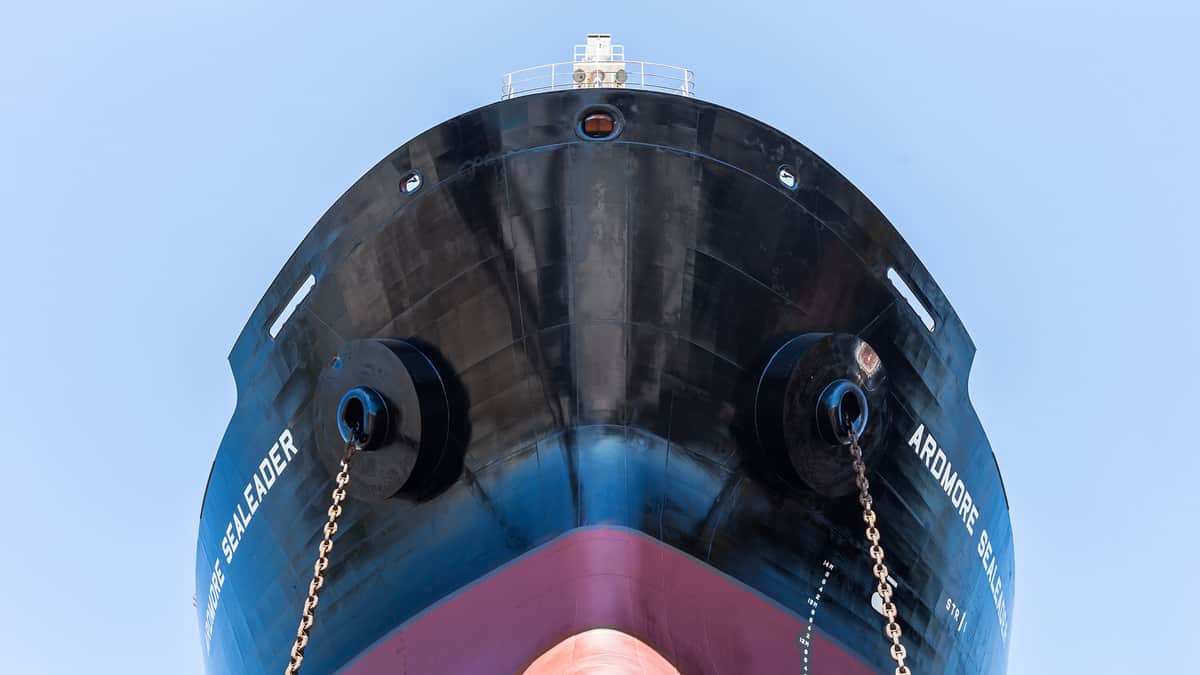Trading of Ardmore Shipping (NYSE: ASC) shares surged to over 10 times normal volume on May 26. Shares closed up 18%. Industry publication Tradewinds attributed the jump to takeover talk. A banking source speaking to FreightWaves agreed. He was getting a lot more client calls than usual about Ardmore over the prior week.
The mystery of that late-May rumor is solved — probably. Loose lips appear to have been whispering about Hafnia Tankers (Oslo: HAFNIA), which is 65% owned by the BW Group.
Hafnia confirmed on Monday that it had sent a proposal for an all-stock takeover deal to Ardmore on June 19. The proposal used Ardmore’s June 12 closing price as the basis, in line with where the stock was trading before the May 26 spike.
Ardmore’s stock rose 16% gain on Monday after Hafnia’s bid was confirmed.
Hafnia makes its move
Hafnia offered Ardmore shareholders 2.4 Hafnia shares for each Ardmore share. Ardmore shareholders would own 17.9% of the combined entity. The merged company would have operated 210 vessels. It would have had the largest product-tanker fleet in the world, topping the fleet of Scorpio Tankers (NYSE: STNG).
Ardmore rejected the takeover offer. It said the bid was “highly opportunistic, substantially undervalued Ardmore and its future prospects, and did not constitute a basis for engaging in discussions.”
But these things don’t necessarily end with the first “no.”
There is no indication yet that Hafnia will go “hostile.” However, Hafnia majority owner BW Group has done so before — unsuccessfully targeting Dorian LPG (NYSE: LPG) for a takeover in 2018.
Furthermore, Stifel analyst Ben Nolan speculated that this could be just an opening gambit, “a shot across the bow.” Nolan thinks a deal is still possible if Hafnia sweetens the bid and if so, Ardmore stock could rise another 10%-20%. He also believes another bidder could emerge, such as International Seaways (NYSE: INSW), Diamond S Shipping (NYSE: DSSI), or Torm (NASDAQ: TRMD).
Hafnia’s offer was “very lowball” and it makes sense that it was rejected, said Jefferies analyst Randy Giveans. But in general, a consolidation deal for Ardmore “would provide them with the scale they desperately need,” he told FreightWaves.
“Many clients of mine say they like the company and management, but that Ardmore is too small for them to own or even trade. This combined entity would likely usurp Scorpio Tankers as the largest product-tanker owner in terms of both fleet and market cap, plus provide the combined company with substantial synergies and cost savings.”
Product-tanker fleet consolidation
Owners consolidate when markets are strong and sellers cash out. They also consolidate when markets are weak and the market forces sellers’ hands. Commercial “pooling” — another path to consolidation — tends to proliferate in weak markets. Pools allow for both cost cuts and more business opportunities.
News of the Hafnia bid comes on the heels of a June 16 announcement by Diamond S that it would form a commercial partnership with Norden (Copenhagen: DNORD). Diamond S contributed 28 medium-range product tankers to the venture, which would market 150 tankers via the Norient Product Pool.
Diamond S is itself a result of merger and acquisition (M&A) activity. It went public last year with a direct listing of its original fleet combined with the tanker fleet of Capital Product Partners (NYSE: CPLP).
Scorpio Tankers has also driven consolidation. It bought the fleet of Navig8 Product Tankers in 2017 and the fleet of Trafigura last year. Meanwhile, Hafnia Tankers is the product of a 2018 merger of the original Hafnia and BW Tankers.
M&A incentives
There’s trouble ahead for tanker owners. Stocks are near 52-week lows. Trading volume is down. Floating-storage destocking will curtail transport demand. Medium-range tanker rates are down 46.5% month-on-month, according to Clarkson’s Platou Securities.

Refineries are suffering from extremely low spreads between the price of crude and products, which could curb their tanker needs.
According to Giveans, consolidation allows product tanker owners to “increase operational scale, which provides better geographical coverage, higher utilization and [more] opportunities for contracts of affreightment [COAs].” A COA is a contract for transport of a certain volume over time that’s not assigned to a specific ship.
“Consolidation tends to provide economies of scale and synergies — lower operating expenses and lower general administrative expenses per day,” he continued, adding that consolidation can also equate to lower interest rates and better capital access.
M&A hurdles
The hurdles to shipping M&A have been there for decades and remain in place. “Many companies have significant insider ownership or private-equity ownership,” said Giveans. “If they are not willing to sell, it’s hard to consolidate.
“Many companies have boards and executives who want to run their own companies and stay independent, for better or worse,” he added.
The other big challenge, particularly in markets like today’s, is valuation. It’s hard to use stock as M&A currency when it’s trading below net asset value (NAV). NAV is the market-adjusted value of the fleet plus other assets, minus debt and other liabilities. “It’s often difficult [for the two sides] to come together when companies are trading at large discounts to NAV,” said Giveans.
According to Clarksons Platou Securities analyst Omar Nokta, “As has been an issue in the shipping sector over the past several years, lack of cash in merger deals makes negotiations more difficult. Without cash, Ardmore would be replacing its discounted valuation with another discounted valuation.”
Nokta noted that “an offer that includes cash would help bridge the valuation gap, though this is likely not realistic given Hafnia’s own discounted price-to-NAV valuation.” Click for more FreightWaves/American Shipper articles by Greg Miller
MORE ON SHIPPING STOCKS: See story here for an overview of the lack of evolution of listed shipping companies over the past decade. How the ‘Robinhood effect’ has spread unevenly across tankers stocks: see story here. Q&A with Deutsche Bank analyst Amit Mehrotra, who is very bullish on transport stocks: see story here.











